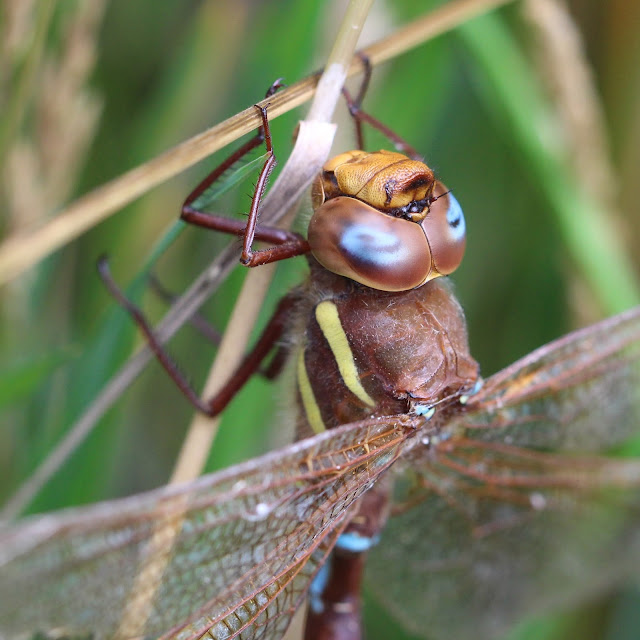It is exactly a week since the red squirrel came to the garden. After he had gone I put up a feeder filled with peanuts, monkey nuts and both shelled and whole hazelnuts. Two days later I saw him on the feeder eating breakfast.
Then he ran onto the lawn and began collecting dried grass and carrying it up an oak tree. I suspected he was building a nest or bivouac and began to hope he might stay around.
Later that day he was back for his tea.
Since then food has been taken from the feeder each day. To save me from spending all day looking out of the window I put up a trail camera and this image is from yesterday.
This morning he turned up for breakfast at around 9.30 so he isn't an early riser. He spent 40 minutes eating and it was interesting that he started with a whole hazelnut. Perhaps it is good for his teeth. Having eaten one he then chose shelled hazelnuts. I can see I'm going to be buying a lot more.
The squirrel seems unconcerned by me standing at the open window 3m away. He takes no notice of the noise of the camera but is very alert to alarms from the birds. I have to be careful not to spook the pigeons while he is on the feeder. It is real thrill having such a beautiful animal in the garden.
My Blog List
Saturday 30 July 2016
Thursday 28 July 2016
Cannibal
Here's something I have never seen before. When I spotted two damselflies in the grass I assumed it was a mating pair but it turned out to be something more sinister.
The female was a blue-tailed damselfly (Ischnura elegans) of rufescens-obsoleta colour form. The male was a common blue damselfly (Enallagma cyathigerum). The slightly gruesome part is that the front end of the male was still alive for a while, or at least his legs were twitching. She eventually discarded the front of the body and sat eating the abdomen.
I am not sure this is true cannibalism as some definitions I found specify that the victim and the perpetrator are the same species but, if not, it's pretty close.
The female was a blue-tailed damselfly (Ischnura elegans) of rufescens-obsoleta colour form. The male was a common blue damselfly (Enallagma cyathigerum). The slightly gruesome part is that the front end of the male was still alive for a while, or at least his legs were twitching. She eventually discarded the front of the body and sat eating the abdomen.
I am not sure this is true cannibalism as some definitions I found specify that the victim and the perpetrator are the same species but, if not, it's pretty close.
Tuesday 26 July 2016
The bee that swallows pollen
I have been on the look out for this bee since being alerted by Louise a couple of weeks ago. It is a Yellow-face Bee (Hylaeus bee) and is tiny, being little bigger than an ant. I managed to take a few photos of females on Astrantia in the garden.
I could see these are female as they have 12 segments in their antennae (rather than the 13 in males) but I was puzzled not to see any sign of a scopa. (That is the pollen-carrying brush in solitary bees, usually either on the hind legs or under the abdomen.) Then I read that the female Hylaeus bee swallows pollen and carries it to the nest in her crop, rather like other bees do with nectar. Here is the bee "eating" pollen from Sweet William (Dianthus barbatus).
I found the males very difficult to photograph because they fly so fast and very rarely land on the flowers. I suppose they must drink nectar at some time but I didn't see it. They are mostly interested in finding a mate. Here two males are attracted to a female on a flower.
The unlucky one, behind, shows his face clearly enough to confirm he is Hylaeus communis, the Common Yellow-face Bee.
Mating is a very brief affair, watched here by an even smaller something, possibly a wasp.
I am amazed at the variety of bees that have been living in my garden without me knowing and by the many ways in which they live. I'm still looking out for more.
Sunday 24 July 2016
Red Alert
The squirrel ran across the kitchen garden, up the hedge, and then across the roof. He disappeared towards the bird feeders.
When I got round to the other side of the house he was climbing down the woodpecker feeder
and then spent the next 25 minutes under the bird feeders. It was interesting that the other birds took no notice of the squirrel on the ground. I think the tree sparrows are the only birds that still have nests.
It is wonderful to see here and gives me hope that they may hang on despite the influx of American greys.
Saturday 23 July 2016
Brown hawker
Finding and identifying brown hawker dragonflies isn't that difficult but photographing them is. Last year I managed to get a photo of one slightly secondhand male for the first time.
Last weekend I found some more at Croome Park in Worcestershire. A few females were ovipositing - the first females I have seen.
As usual the males were flying non-stop on patrol so I tried a few flight shots.
Last weekend I found some more at Croome Park in Worcestershire. A few females were ovipositing - the first females I have seen.
As usual the males were flying non-stop on patrol so I tried a few flight shots.
I haven't yet seen brown hawker here in the North East although according to the British Dragonfly Society website they do get this far north. I'll be keeping my eyes open.
Subscribe to:
Posts (Atom)


















































